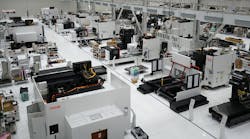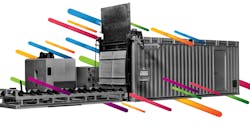Sadly, there is no single best practice for incorporating or adopting Industrial Internet of Things (IIoT) equipment and devices within your machine shop. There are, however, measurable benefits for doing so — including a considerable boost to machining and performance data, that can help improve operations for the better. That is the promise of IIoT, after all: that data exchange among and between machines and data networks will enhance manufacturing processes by delivering critical new information for orders, for machine tolerances, or for innumerable other reference points that enhance performance.
The promise of better performance has empowered many machine shops to make the leap and deploy IIoT technologies within their processes and operations. As a result, we are able to discern many “do’s” and “don’ts” for working with the tech.
1. Identify what’s worth smartening up or automating — It’s easy to fall into the trap of thinking a “smart factory” or smart facility is outfitted all the way with modernized hardware, but that’s not always the case. Smart factories are simply what the name implies: properties that operate under smarter and more efficient conditions, generally through the augmentation of today’s tech.
The point is, don’t just start incorporating smart and connected hardware for the heck of it. Instead, take some time to understand what’s available and where it will benefit your business and operations best. You may find there are fewer systems that could utilize IIoT setups than you initially thought, or you may find the exact opposite. In precision machining especially, there are incredibly nuanced systems already at play, and it might not be worth swapping them out for a more modern tool, unless there are significant benefits.
Before deploying a new piece of tech or machinery, consider if it will help or improve your operations and business. If not, there’s no reason to bother right now.
2. Coordinate with your manufacturing and assembly partners — Machine shops are frequently just one cog in the wheel when it comes to manufacturing and assembling goods, so it’s always necessary to coordinate with partners and other parties further down the supply chain.
Find out what IIoT and systems your partners are using currently and ensure that any you are considering will not cause complications. Furthermore, ensure there is ample compatibility between devices, hardware, and systems so you aren’t hindered in any way when working with your partners. They will be adopting modern technologies too, including IIoT.
From 2016 to 2020, the percentage of manufacturers expected to be highly digitized has more than doubled, from 33% of businesses to 72%.
3. Scale security with your network — As your network grows, you’ll want to secure anything and everything connected to it. More devices will be accessing the network, more data will be generated and transferred, and more vulnerabilities will become available. It must all be balanced with strong and capable endpoint security that works to keep out unscrupulous parties. Powerful data encryption also should be used to protect and secure content.
4. Know what you’ll be doing with the data — Before implementation, you must ensure that you are committed to using the devices you choose and, by proxy, the data said equipment generates. You will be collecting copious amounts of information from a variety of sources. What are you going to do with it? How are you going to organize, process and convert it for use with your regular operations?
Will you be implementing predictive measures that rely on incoming data? Will you be using real-time insights to navigate, adjust and adapt your operations? These are just a handful of things you should consider. You must understand what your data initiatives are and how you’ll be using the information at your disposal.
And since knowing what to do with the incoming data is the biggest hurdle posed in the aftermath of implementation, it's important for you to get it right. The sooner the better, too. Early IIoT adopters could experience a productivity boost of 30% or more as a result of the new methods, data, and conveniences offered.
5. Know your end-user — With any form of IIoT, transmitting data and information to the end-user is the purpose. Smart home technologies, for example, allow homeowners more control over what’s happening with their property and systems, such as the lighting, cooling and air, or even operating appliances. Believe it or not, the same concept holds true for industrial-based IIoT equipment.
Who is your primary end-user? Who will be receiving, reacting to and using the data flowing in or out?
As a machine shop, your end-users are not going to be the same as any other business. You’re mostly looking at partners, fellow manufacturers and even supply chain operators. Know who the focus is for the particular system you’re deploying, and make sure the data is available and accurate for them.
6. Measure improvements and ROI — IIoT functionality is implemented for one major reason: the benefits and conveniences it can deliver that will result in higher efficiencies, output, and performance. But you don’t suddenly have access to an out-of-the-box system or tool for tracking the ROI of the equipment you install. It’s on you to come up with a system or structure for measuring and monitoring this data.
How can you be sure a new system or device is helping or hurting your operations? Are there financial benefits? Are the costs even worth what’s being provided?
7. Don’t forget about the people — When adopting new technologies — especially IIoT, which enhances automation opportunities — it’s easy to forget there are still people behind the scenes helping oil the gears. For IIoT and tech, maintenance and operations crews monitor what’s happening and fix any potential problems. Data scientists or analysts will help sort through the incoming information and turn it into more actionable insights. Engineers and developers will help create entirely new systems and tools that can be used to improve machine processes and hardware.
At the root of all of this, it’s important that you have a talented and reliable crew at the ready to help manage and maintain any IIoT network you deploy. The help may be internal or outsourced, it doesn’t matter — just make sure it’s exceptional either way.
Stick to these tips, at least initially, and you’ll have a well-intentioned and accurate IIoT system and network at your disposal.
Megan Nichols is a STEM writer and blogger covering a wide range of scientific topics at schooledbyscience.com. Her recent contributions to AmericanMachinist.com, have included Tips for Implementing CNC Machine Preventive Maintenance and What Does ISO 9001:2015 Mean for Machine Shops?, and many others. Follow Megan on Twitter @nicholsrmegan.








